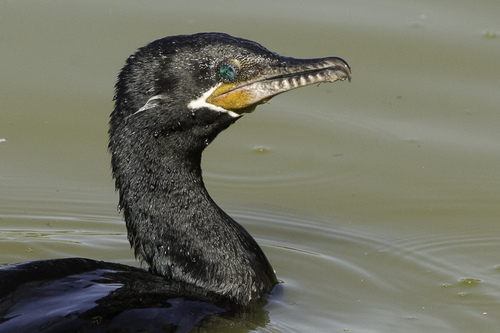
Neotropic Cormorant
The Neotropic Cormorant (*Nannopterum brasilianum*) is a widespread and adaptable waterbird found throughout the Americas, from the southern United States to the tip of South America. It plays a crucial role in its aquatic ecosystems as a predator of fish and other small aquatic animals. Unlike some other cormorant species, the Neotropic Cormorant often frequents freshwater habitats in addition to coastal environments. It is sometimes known locally by other names, like 'biguá' in parts of South America. Its presence is often an indicator of healthy water bodies and abundant fish stocks.
58-73 cm
Length
90-105 cm
Wingspan
Least Concern
Conservation Status
Distribution
The Neotropic Cormorant's range extends from the southern United States (Texas, Louisiana, and occasionally further north) through Mexico, Central America, and South America, reaching as far south as Tierra del Fuego. It is also found in the Caribbean. It's not a highly migratory species, but some populations may undertake local movements in response to water availability or food resources.
Lifespan
The average lifespan in the wild is not well documented but is estimated to be around 6-10 years. Captive individuals can live longer.
Neotropic Cormorant's Habitat
Habitat Types
Coastal waters, Estuaries, Rivers, Lakes, Reservoirs, Mangrove swamps, Freshwater marshes
Climate Zones
Tropical, Subtropical, Temperate
Adaptations
Neotropic Cormorants have webbed feet for efficient swimming and diving. Their feathers are less waterproof than those of many other waterbirds, requiring them to frequently perch with wings outstretched to dry. This behavior is a common sight near water bodies where they occur. They also possess a gular pouch, a sac of skin on the throat that is used to help capture and hold fish.
Variations
While some authorities recognize subspecies based on minor size and plumage differences, these distinctions are not universally accepted.
Appearance
Breeding Plumage
Breeding adults have glossy black plumage with a greenish sheen. They develop small white plumes on the sides of their head and neck, and a whitish border to the gular pouch. Non-breeding adults are duller and lack the white plumes.
Seasonal Feather Changes
Plumage variations are primarily related to breeding status, as described above.
Sex Based Plumage Differences
While both sexes are similar in appearance, males are slightly larger and may have more pronounced breeding plumage characteristics.
Notable Features
Long, hooked bill, Webbed feet, Dark, glossy plumage, Gular pouch (throat sac), White plumes on head and neck during breeding season
Diet and Feeding
Primary Foods
Small fish, Crustaceans, Amphibians, Aquatic insects
Foraging Behavior
Neotropic Cormorants are pursuit divers, swimming underwater to chase and capture prey. They typically forage in relatively shallow water, often near the shore or in areas with submerged vegetation. They may forage alone or in small groups.
Specializations
Their hooked bill helps them grasp slippery fish. Their dense bones, unlike many birds with hollow bones, aid in diving by reducing buoyancy.
Seasonal Diet Variations
Diet may vary depending on prey availability, which can fluctuate seasonally. For instance, they might consume more crustaceans during certain times of the year when these are abundant.
Behavior
Social Structure
Neotropic Cormorants are often seen in flocks, both when foraging and roosting. They can form large colonies during the breeding season.
Communication
Guttural calls, Croaking sounds, Visual displays (e.g., wing-waving, head-bobbing)
Migration
Most populations are non-migratory or undertake only short-distance movements. However, some populations at the extreme northern and southern ends of their range may show more pronounced seasonal movements.
Territorial or Group Behaviors
During the breeding season, pairs defend a small territory around their nest. Outside of the breeding season, they are generally more social and may forage and roost in large groups.
Conservation
Threats
Habitat destruction (wetland drainage, deforestation), Pollution (pesticides, heavy metals), Entanglement in fishing gear, Disturbance at breeding colonies, Climate change (affecting prey availability)
Protection Programs
Wetland conservation and restoration efforts, Regulations to reduce pollution, Measures to reduce bycatch in fisheries, Protection of breeding colonies
Local National Laws
Protected under various national and international laws, including the Migratory Bird Treaty Act in the United States.
Population Trend
Stable
Population Estimates
The global population is estimated to be between 2,000,000 and 20,000,000 individuals.
Interesting Facts
They often perch with their wings outstretched.
This behavior is thought to help them dry their feathers, which are not as waterproof as those of some other waterbirds.
They are excellent underwater swimmers.
They use their webbed feet to propel themselves through the water in pursuit of prey.
They can be found in both freshwater and saltwater habitats.
This adaptability allows them to occupy a wide range of environments.
They are sometimes confused with Anhingas.
Both species are dark-colored waterbirds with long necks, but Anhingas have a straight, pointed bill, while cormorants have a hooked bill.
Faqs about Neotropic Cormorant
Are Neotropic Cormorants endangered?
No, they are classified as Least Concern by the IUCN.
What do Neotropic Cormorants eat?
They primarily eat small fish, but also consume crustaceans, amphibians, and aquatic insects.
Where do Neotropic Cormorants live?
They are found throughout the Americas, from the southern United States to South America, in a variety of aquatic habitats.
Do Neotropic Cormorants migrate
Most do not migrate long distances. Some populations may make short, local movements.
Copyright @ Nature Style Limited. All Rights Reserved.
 English
English